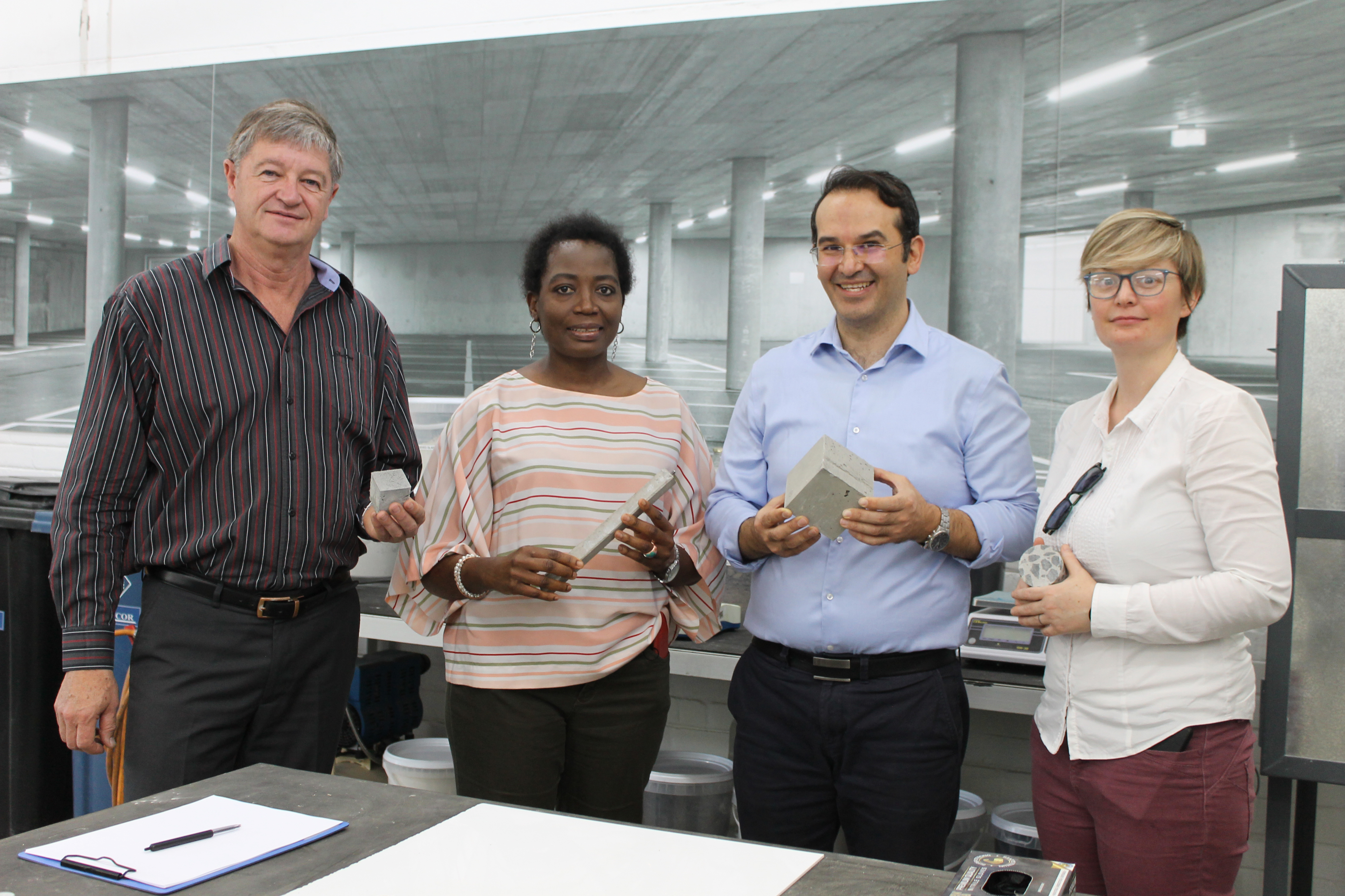29 November 2022
|
Story Leonie Bolleurs
|
Photo Leonie Bolleurs
 The Department of Engineering Sciences (EnSci) welcomes collaborations with other departments at the UFS. Pictured here are, from the left: Louis Lagrange, Head of EnSci, Prof Kahilu Kajimo-Shakantu, Head of the Department of Quantity Surveying and Construction Management, Dr Abdolhossein Naghizadeh, and Megan Welman-Purchase, analytical scientist in the Department of Geology.
The Department of Engineering Sciences (EnSci) welcomes collaborations with other departments at the UFS. Pictured here are, from the left: Louis Lagrange, Head of EnSci, Prof Kahilu Kajimo-Shakantu, Head of the Department of Quantity Surveying and Construction Management, Dr Abdolhossein Naghizadeh, and Megan Welman-Purchase, analytical scientist in the Department of Geology.
More than 30 million tonnes of fly ash (residue from coal combustion in power plants) are generated in South Africa annually, with 96% of that being disposed of in landfills. There is thus more than enough of this key ingredient to produce green concrete.
Green concrete, so called due to its environmentally friendly benefits, is an eco-friendly alternative to conventional concrete based on the Portland cement binder. During the production of green concrete, less carbon dioxide is released into the atmosphere
than with the production of ordinary Portland cement (OPC). The latter accounts for up to 8% of all global carbon emissions.
Successful tests
He uses ‘geopolymer’ technology and a mix of waste materials, alkaline solutions, and recycled aggregates to form concrete mixtures that can provide properties similar to conventional concrete.
Besides being a synthesised inorganic material (not a petrochemical product), the geopolymer cement he introduced has the following properties: it is made from a reaction between aluminosilicate materials and strong alkalis (5-7% of the concrete mixture),
it uses water and by-products as raw materials, it does not calcinate lime, thus giving it a low carbon emission, and it is also beneficial from a waste management point of view.
The waste materials used can include waste from industrial and agricultural sources, such as fly ash, rice husk ash, sugar-cane bagasse, or corncob ash, as well as natural materials such as volcanic ash. In South Africa, sufficient amounts of industrial
and agricultural waste are available.
“So far, we have successfully tested various types of green concrete based on different waste materials,” says Dr Naghizadeh.
Besides researching the green mixture proportions in the lab, Dr Naghizadeh and his students focused their attention on establishing the strength, durability, workability, and production cost of the product.
They compared green concrete with conventional concrete. Green concrete’s workability is slightly lower (but he believes that with appropriate mix design it can be corrected), and it has a much higher compressive strength (50-90 MPa), a smaller
carbon footprint, and comparable production costs to conventional concrete (depending on the mix design). A very high level of resistance against alkali-silica reaction (concrete cancer) is also present, as well as resistance to carbonation, sulphate
attack, and acid attack.
So far, we have successfully tested various types of green concrete based on different waste materials.– Dr Naghizadeh.
He explains, “The superior durability performance of green concrete is related to its chemical compositions and microstructure. For example, the lack of calcium content in the composition provides better resistance to alkali-silica reaction. At
the same time, stronger bonds between elements and polymeric microstructure provide better resistance against acids and fire.”
With all the work and research of the past year and a half, Dr Naghizadeh says they are at the stage where they can prescribe green concrete production recipes for the industry parties based on the specified application and the materials they have.
Biggest accomplishments
“We transferred most of the experimental works to the Green Concrete Lab at the beginning of 2022, which improved our productivity tremendously. Since then, nine journal papers and three peer-reviewed conference papers have been published as outputs
of the research projects. Currently, there are also multiple publications under review or in the development stages,” says Dr Naghizadeh.
In addition to him, there are three master's students and one research associate working on their own individual projects.
The department is very proud of its research outputs. Dr Naghizadeh was either author or co-author of all 12 research papers. The focus of these papers was mostly on the formulation of green concrete, based on locally available agricultural waste materials,
the formulation of one-part geopolymer cement (when aluminosilicate raw material is replaced with pre-activated aluminosilicate material, water can be used instead of alkali solution), and the development of ambient-cured green concrete (replacing
the aluminosilicate raw material with a blend of materials).
Dr Naghizadeh is also the project leader of a group of scientists from local and international universities who are researching sustainable construction materials. These institutions include the Universities of Johannesburg, KwaZulu-Natal, Yaoundé
in Cameroon, Erzurum Technical University in Turkey, as well as Nelson Mandela University and the Central University of Technology, which recently came on board.